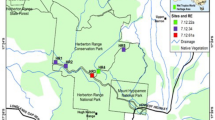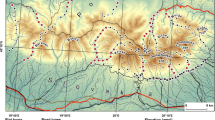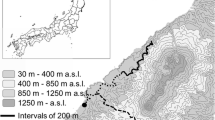Abstract
Most of the Chilean traffic exchange takes place along the border with Argentina. The road network between both countries facilitates the transport of alien plant species, raising the chance of new introductions of plant species and increasing the propagule pressure of already introduced plants. We used a modified version of the Australian Weed Risk Assessment method (AWRA) to analyze if alien plant species already present either exclusively in Chile or Argentina can be a potential source of risk for new alien species introduction and, specifically, which of the two countries poses a higher risk for its counterpart. We recorded 875 alien species of which 288 are exclusive to Chile, 283 are exclusive to Argentina, and 304 are shared by both countries. Considering the risk of new alien plants introductions, Chile presents a higher threat to Argentina than vice versa. Specifically, twenty-two alien species are exclusive to Chile, and are present on roadsides connecting both countries, hence they are regarded as a top risk for Argentina; a comparable top risk of alien species is absent from Argentinean roadsides. Both countries have a similar number of alien species being exclusive to one country, but are not present along roadsides (Chile 162; Argentina 186), which could represent a potential risk to the other country. The methodological approach proposed here may be a useful tool not only for screening potential new alien plant introductions, but also for the prioritization of eradication or control measures of those species already introduced.

Similar content being viewed by others
References
Armesto JJ, Rozzi R, Smith-Ramírez C, Arroyo MKT (1998) Conservation targets in South American temperate forests. Science 279:1271–1272
Arroyo MTK, Cavieres L, Peñaloza A, Riveros M, Faggi AM (1997) Phytogeographic relationships and species richness patterns in the temperate rain forest flora of South America. In: Armesto JJ, Villagrán C, Arroyo MTK (eds) Ecología de los bosques nativos de Chile. Editorial Universitaria, Santiago de Chile, pp 71–100
Arroyo MTK, Rozzi R, Simonetti JA, Marquet P, Sallaberry M (1999) Central Chile. In: Mittermeier RA, Myers N, Robles-Gil P, Goettsch-Mittermeier C (eds) Hotspots: earth’s biologically richest and most endangered terrestrial ecosystems. Cemex, Conservation International, Ciudad de México, pp 161–171
Arroyo MTK, Marticorena C, Matthei O, Cavieres L (2000) Plant invasions in Chile: Present patterns and future predictions. In: Mooney HA, Hobbs RJ (eds) Invasive species in a changing world. Island Press, USA, pp 385–421
Cowling RM, Rundel PW, Lamont BB, Kalin-Arroyo M, Arianoutsou M (1996) Plant diversity in Mediterranean-climate regions. Trends Ecol Evol 11:362–366
Crawley MJ (1987) What makes a community invasible? In: Gray AJ, Crawley MJ, Edwards PJ (eds) Colonization, succession and stability. Blackwell Scientific, Oxford, pp 429–453
Daehler C (2005) Invasive species. In: Mueller-Dombois D, Bridges KW, Daehler C (eds) Biodiversity assessment of tropical island ecosystems PABITRA manual for interactive ecology and management. Honolulu, Hawaii, pp 197–208
Daehler C, Carino DA (2000) Predicting invasive plants: prospects for a general screening system based on current regional models. Biol Invasions 2:92–103
Daehler C, Denslow JS (2007) The Australian weed risk assessment system: does it work in Hawaii? Would it work in Canada? In: Clements DR, Darbyshire SJ (eds) Invasive plants: inventories, strategies and action–Topics in Canadian Weed Science. Canadian Weed Science Society, Québec, pp 9–24
Daehler C, Denslow JS, Ansari S, Kuo H (2004) A risk assessment system for screening out harmful invasive pest plants from Hawaii and other Pacific Islands. Conserv Biol 18:360–368
Dawson W, Burslem D, Hulme P (2009) The suitability of weed risk assessment as a conservation tool to identify invasive plants threats in East African rainforests. Biol Conserv 142:1018–1024
Delisle F, Lavoie C, Jean M, Lachance D (2003) Reconstructing the spread of invasive plants: taking into account biases associated with herbarium specimens. J Biogeogr 30:1033–1042
Fuentes N, Ugarte E, Kühn I, Klotz S (2008) Alien plants in Chile: inferring invasion periods from herbarium records. Biol Invasions 10:649–657
Gordon D, Onderdonk D, Fox A, Stocker R (2008) Consistent accuracy of the Australian weed risk assessment system across varied geographies. Divers Distrib 14:234–242
Holm L, Plucknett DL, Pancho JV, Herberger JP (1977) The world’s worst weeds. University Press of Hawaii, Honolulu
Holm L, Pancho JV, Herberger JP, Plucknett DL (1979) A geographical atlas of world weeds. Wiley-Interscience, New York
Hulme P (2003) Biological invasions: winning the science battles but losing the conservation war? Oryx 37:178–193
Keller RP, Lodge DM, Finnoff DC (2007) Risk assessment for invasive species produces net bioeconomic benefits. Proc Natl Acad Sci USA 104:203–207
Kolar CS, Lodge DM (2001) Progress in invasion biology: predicting invaders. Trends Ecol Evol 16:199–204
Kowarik I (1995) Time lags in biological invasions with regard to the success and failure of alien species. In: Pyšek P, Prach K, Rejmànek M, Wade M (eds) Plant invasions: general aspects and special problems. SPB Academic Publishing, Amsterdam, pp 15–38
Kühn I, Durka W, Klotz S (2004) BiolFlor–a new plant-trait database as a tool for plant invasion ecology. Divers Distrib 10:363–365
Küster C, Kühn I, Bruelheide H, Klotz S (2008) Trait interactions help explain plant invasion success in the German flora. J Ecol 96:860–868
Mack RN, Simberloff D, Lonsdale WM, Evans H, Clout M, Bazzaz FA (2000) Biotic invasions: causes, epidemiology, global consequences, and control. Ecol Appl 10:689–710
Matthei O (1995) Manual de las malezas que crecen en Chile. Alfabeta Impresores, Chile
Myers N, Mittermeier RA, Mittermeie CG, da Fonseca G, Kent J (2000) Biodiversity hotspots for conservation priorities. Nature 403:853–858
Noble IR (1989) Attributes of invaders and the invading process: terrestrial and vascular plants. In: Drake JA, Mooney HA, di Castri F, Groves RH, Kruger FJ, Rejmanek M, Williamson MH (eds) Biological invasions: a global perspective. Wiley, Chichester, pp 301–313
Pauchard A, Cavieres L, Bustamante R, Becerra P, Rapoport E (2004) Increasing the understanding of plant invasions in southern South America: first symposium on alien plant invasions in Chile. Biol Invasions 6:255–257
Pheloung PC, Williams PA, Halloy SR (1999) A weed risk assessment model for use as a biosecurity tool evaluating plant introductions. J Environ Manage 57:239–251
Pimentel D, Zuniga R, Morrison D (2005) Update on the environmental and economic costs associated with alien-invasive species in the United States. Ecol Econ 52:273–288
Pyšek P, Prach K (1993) Plant invasion and the role of riparian habitats: a comparison of four species alien to central Europe. J Biogeogr 20:413–420
Pyšek P, Richardson DM (2007) Traits associated with invasiveness in alien plants: Where do we stand? In: Nentwig W (ed) Biological invasions, ecological studies 193. Springer, Berlin, pp 97–126
Reichard SH, Hamilton CW (1997) Predicting invasions of woody plants introduced into North America. Conserv Biol 11:193–203
Sakai AK, Allendorf FW, Holt JS, Lodge DM, Molofsky J, With KA, Baughman S, Cabin RJ, Cohen JE, Ellstrand NC, McCauley DE, O’Neil P, Parker IM, Thompson JN, Weller SG (2001) The population biology of invasive species. Annu Rev Ecol Syst 32:305–332
Settele J, Hammen V, Hulme P, Karlson U, Klotz S, Kotarac M, Kunin WE, Marion G, O’Connor M, Petanidou T, Peterson K, Potts S, Pritchard H, Pyšek P, Rounsevell M, Spangenberg J, Steffan-Dewenter I, Sykes MT, Vighi M, Zobel M, Kühn I (2005) ALARM: assesing LArge scale environmental risks for biodiversity with tested methods. GAIA–Ecol Perspect Sci Humanit Econ 14:69–72
Simberloff D (2009) We can eliminate invasions or live with them. Successful management projects. Biol Invasions 11:149–157
Tucker KC, Richardson DM (1995) An expert system for screening potentially invasive alien plants in South African Fynbos. J Environ Manage 44:309–338
Ugarte E, Fuentes N, Klotz S (in press) European plant in southern South America, unwanted visitors? In: Settele J (ed) Atlas of biodiversity risks–from Europe to the globe, from stories to maps. Pensoft, Sofia, Moscow
Veblen TT, Schlegel FM, Oltremari JV (1983) Temperate broad-leaved evergreen forest of South America. In: Ovington JD (ed) Temperate broad-leaved forest. Elsevier Science Publisher, Amsterdam, pp 5–31
Vitousek P, Mooney H, Lubchenco J, Melillo J (1997) Human domination of earth′s ecosystems. Science 277:494–499
Weber E (2003) Invasive plant species of the world: a reference guide to environmental weeds. CABI Publishing, Wallingford
Weber J, Panetta D, Virtue J, Pheloung P (2009) An analysis of assessment outcomes from eight years’ operation of the Australian border weed risk assessment system. J Environ Manage 9:798–807
Westbrooks RG (1991) Plant protection issues I. A commentary on new weeds in the United States. Weed Technol 5:232–237
Zuloaga F, Morrone O (1996) Catálogo de las plantas vasculares de la República Argentina I. Pteridophyta, Gymnospermae y Angiospermae (Monocotyledoneae). Monogr Syst Bot Mo Bot Gard 60:1–323
Zuloaga F, Morrone O (1999) Catálogo de las plantas vasculares de la República Argentina (Dicotyledoneae). Monogr Syst Bot Mo Bot Gard 74:1–1246
Acknowledgments
We thank to M. Winter for providing us partial electronic data of flora Argentina, F. Lira for roadside data, S. Fuentes for helping in completing the WRA-ChAr forms, and C. Heibl, S. Pfanzelt, and A. Saldaña for their comments on the analysis and the manuscript. We also thank D. Simberloff and two anonymous reviewers for helpful comments on a previous version of the manuscript. This research was funded by the EC within the FP 6 Integrated Project ALARM (Assessing LArge scale environmental Risks for biodiversity with tested Methods; GOCE-CT-2003-506675; www.alarmproject.net; Settele et al. 2005).
Author information
Authors and Affiliations
Corresponding author
Electronic supplementary material
Below is the link to the electronic supplementary material.
Rights and permissions
About this article
Cite this article
Fuentes, N., Ugarte, E., Kühn, I. et al. Alien plants in southern South America. A framework for evaluation and management of mutual risk of invasion between Chile and Argentina. Biol Invasions 12, 3227–3236 (2010). https://doi.org/10.1007/s10530-010-9716-9
Received:
Accepted:
Published:
Issue Date:
DOI: https://doi.org/10.1007/s10530-010-9716-9




